
Gastronomy of Porto and Northern Portugal
Trás-os-Montes
What to Do
At the table with Porto and Northern Portugal: traditions, flavors and experiences
In Porto and Northern Portugal, gastronomy is a celebration of authentic flavors and centuries-old traditions. Here, every dish tells a story, inviting us to explore the richness of local ingredients, masterfully crafted by the region’s people.
From hearty Trás-os-Montes meats to the fresh seafood of Matosinhos, generations-old recipes reflect the essence of the land and the sea, as well as the generosity of its inhabitants.
This is an invitation to sit at the table, share stories, and discover why Porto and Northern Portugal are synonymous with exceptional food and unmatched hospitality.
A journey through the flavors of Porto and Northern Portugal
The gastronomy of Porto and Northern Portugal is a reflection of its history, geography, and deep-rooted traditions, resulting in a diverse range of dishes that celebrate the richness of local ingredients. In the North, cuisine is defined by its authenticity and generosity of flavors.
Since medieval times, trade with other peoples, particularly the Galicians and North Sea nations, introduced new influences that enriched the northern Portuguese diet.
Did you know that pork became a cornerstone of local cuisine?
This was due to the tradition of using the entire animal, leading to the creation of delicacies like rojões and the traditional Mirandela alheira. The alheira has a fascinating history, dating back to the 16th century, when New Christians (converted Jews) developed this smoked sausage as a way to blend in, creating a pork-like alternative without actually containing it, thus avoiding religious persecution.
The sea plays an essential role in the gastronomy of Porto and Northern Portugal. The city of Porto, strategically located along the Douro River and the Atlantic Ocean, always had a strong fishing culture, shaping many of its traditional dishes.
There are many restaurants where you can sample the local cuisine, as well as tours that guide you through a variety of tastings. Here are some of the restaurants you might want to try: Taste Porto, Simply B, Fábrica do Azeite, Euskaluna, Restaurante A Cozinha, Vinum, Restaurante Real, Mind the Glass, Doc, Dop, Casa de Chá, Oficina, Avillez, and Espaço Porto Cruz.
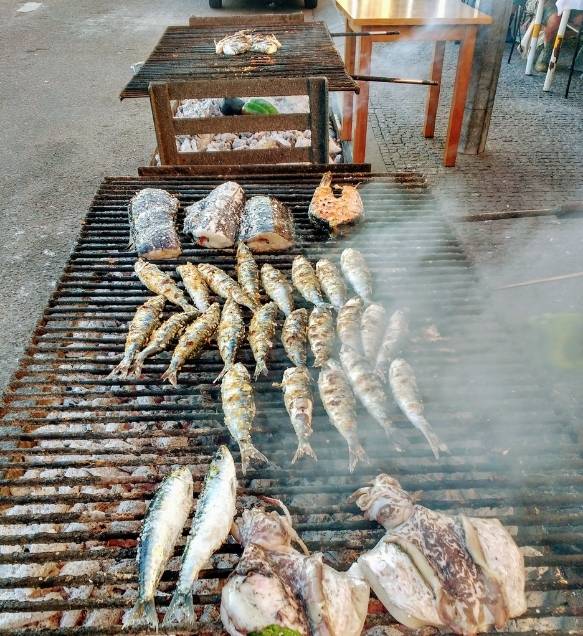
Matosinhos: World’s Best Fish
Matosinhos stands out as one of Europe’s top gastronomic destinations, boasting an impressive concentration of restaurants in a small area. With around 600 dining establishments, the city offers everything from traditional charcoal-grilled fish to high-end international cuisine, with a special emphasis on seafood and fresh fish, delivered daily from the Matosinhos and Angeiras fish markets.
In Matosinhos’ restaurants, visitors can indulge in seabass, lobster, octopus, codfish, and the iconic sardine, prepared in various ways, including grilled, in seafood stew (caldeirada), or cooked in a cataplana. The famous seafood rice (arroz de marisco) is another must-try dish, showcasing the rich flavors of the Atlantic.
Wine, with a special emphasis on Port Wine, has become a symbol of prestige and festivity. This renowned beverage was born out of English merchants’ need to preserve wine during long maritime journeys, leading them to fortify it with brandy, thus creating the celebrated nectar we know today. Wine production has deep roots, intricately linked to the economic and cultural development of the Douro Valley, one of the oldest demarcated wine regions in the world, established in 1756.
Northern Portuguese gastronomy goes beyond the dish: it is a celebration of community culture, where long meals are filled with stories, laughter, and shared traditions. From the francesinha, Porto’s modern culinary icon, to the Trás-os-Montes-style cozido à portuguesa, the rich tapestry of flavors reflects the soul of its people. Each recipe carries the legacy of past generations, inherited traditions, and the resilience of a people who have mastered the art of transforming humble ingredients into extraordinary delicacies.
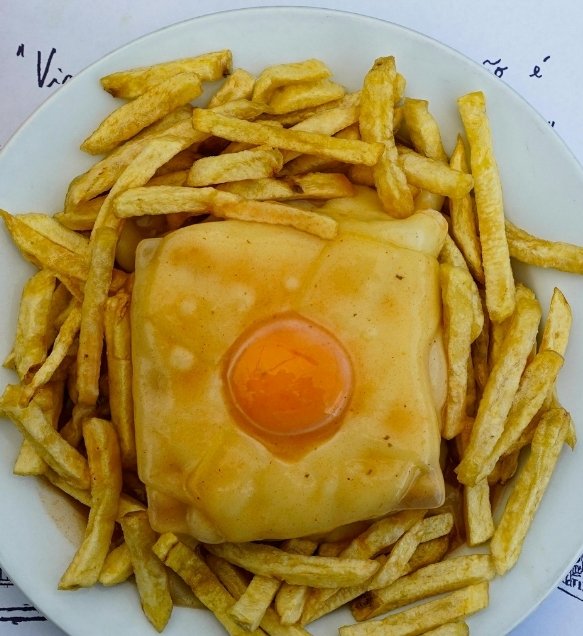
Francesinha: “A nation on a plate”
The francesinha is one of the most iconic dishes in Porto’s gastronomy, celebrated for its rich flavors and unique recipe, winning over both locals and visitors alike.
This legendary dish was inspired by the classic French croque-monsieur, but with a Portuguese twist: stronger flavors, heartier ingredients, and bolder seasoning. It was created in the 1950s by a Portuguese emigrant who had returned from France and decided to adapt the dish to Portuguese tastes, making it more substantial and packed with flavor. Today, the francesinha is more than just a dish, it is an institution in Porto, embodying the city’s gastronomic soul and the generosity of its people.
A francesinha consists of various meats - including ham, linguiça, fresh sausage, and steak - layered between slices of bread, covered with melted cheese, and drenched in a thick, spicy sauce that is the true essence of the dish. It is typically served with a fried egg on top and accompanied by crispy French fries.
Wine tourism: wine and gastronomy in perfect harmony
The wine heritage of Northern Portugal could not be more remarkable. The region is traversed by the Douro River, whose vineyard landscapes have been recognized as a UNESCO World Heritage Site. It is also home to Porto, the city that gave its name to the world-famous Port Wine, exported across the globe. Additionally, the region includes the Vinho Verde and Távora-Varosa wine areas, making it a true reference in the world of winemaking.
With such a diverse wine selection, Porto and Northern Portugal offer the perfect wine for every type of meal:
- Vinho Verde and sparkling wines, light and refreshing, pair beautifully with appetizers, light dishes, salads, fish, seafood, and white meats.
- For rich dishes and red meats, the full-bodied wines from the Douro, particularly those from Douro Superior, are the ideal choice.
- Port Wines, whether Tawny, Colheita, or Vintage, turn any occasion into a special celebration.
- And, of course, for toasts and unforgettable moments, high-quality sparkling wines - for which the Távora-Varosa region is renowned - are the ultimate selection.
Port Wine, internationally acclaimed, is produced on the slopes of the Douro Valley and serves as the perfect accompaniment to many of the region’s traditional dishes. Wine tourism has been gaining increasing prominence, offering visitors the opportunity to explore the vineyards, participate in wine tastings, and learn more about the winemaking process, including how to pair wines with Porto’s rich and diverse cuisine.
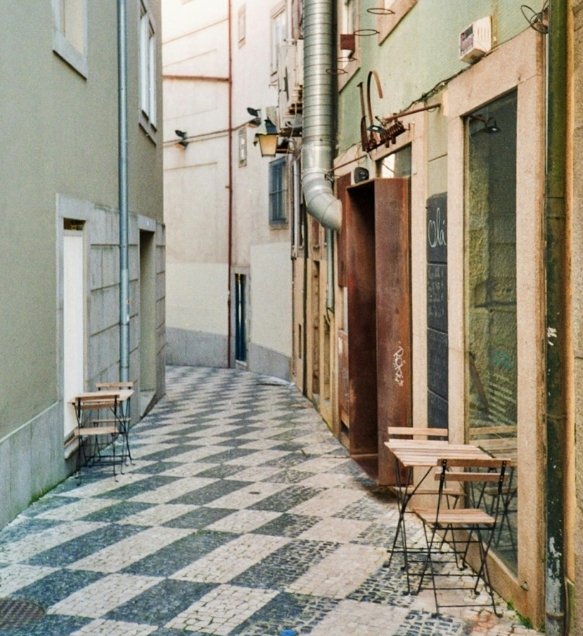
"Fazer das Tripas Coração": the story behind Porto’s iconic dish
The origins of "Tripas à Moda do Porto" are steeped in legend and remain a vital part of the city’s history and culinary identity. This tradition dates back to the 15th century, specifically to the era of the Portuguese Maritime Expeditions, and is closely linked to the preparations for the conquest of Ceuta in 1415.
According to popular legend, when Prince Henry the Navigator requested support from the city of Porto to provision the departing fleets, the citizens displayed extraordinary generosity. They offered nearly all the available meat to sustain the sailors and soldiers, keeping only the offal for themselves. With the finest cuts sent away, Porto’s people had to get creative to prepare hearty and flavorful meals using what remained - the tripe.
Thus was born "Tripas à Moda do Porto", a dish made from beef tripe, assorted sausages, white beans, and a blend of aromatic spices. This meal became a symbol of resilience and sacrifice, so much so that the people of Porto earned the nickname "Tripeiros" - a term that, far from being derogatory, is now embraced with pride. It reflects the strength, generosity and unwavering spirit of the people of Porto, who literally gave their best to others while making the most of what they had.
Let’s sit at the table: flavors with a northern accent
Let’s sit at the table and allow our eyes and palate to savor some of the iconic flavors that define Northern Portugal. From hearty meat dishes, rooted in the rural countryside, to the fresh Atlantic flavors that shape the coastal cities, the Northern Portuguese table is an invitation to discovery. Each dish tells a story, carries a legacy, and reflects the people who make this region a truly special place.
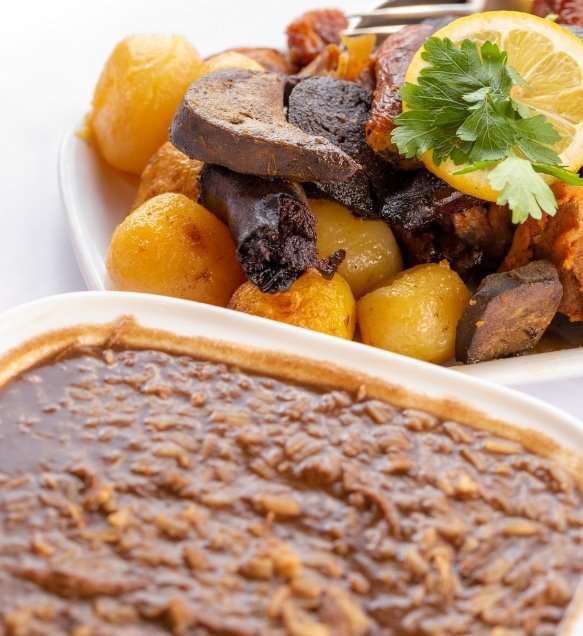
Arroz de Sarrabulho (Ponte de Lima)
A traditional Minho dish, Arroz de Sarrabulho is made with rice, various types of meat, blood, spices (especially cumin), and vinegar. While this dish can be found throughout Portugal, it is most commonly enjoyed in the North.
Whether served as rice or in a porridge-like consistency (papas de sarrabulho), this meal is deeply associated with family gatherings and communal celebrations, typically prepared after the pig slaughter, making full use of the animal’s resources. In addition to blood, sarrabulho includes pork offal, such as the heart, liver, tongue, and throat—ingredients that contribute to its rich and distinctive flavor.
Arroz de cabidela
Arroz de Cabidela is especially popular in Northern Portugal, particularly in the Minho region. It is prepared with chicken blood, which is mixed into the rice and the meat of the chicken itself. In Minho, this dish is traditionally made with free-range chicken, known as "galinha de campo", and is often referred to as "frango pica no chão"—a name inspired by the way these chickens scratch the ground for food.
Did you know…? The word "cabidela" comes from the term "cabido", which refers to the contents of a bird’s belly, including its offal and blood.
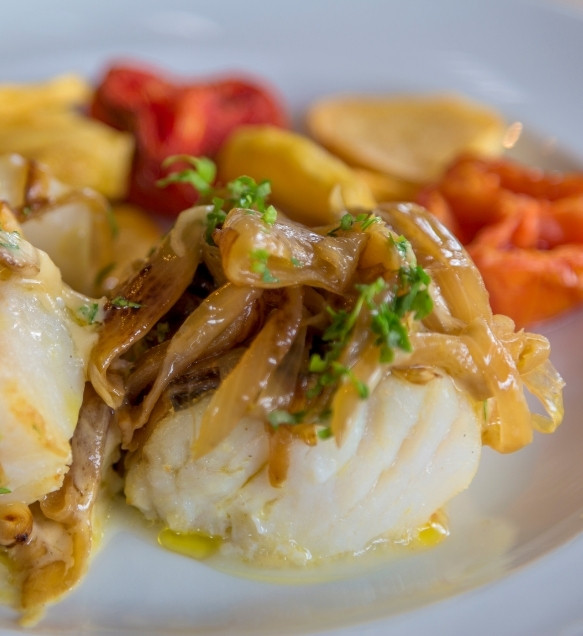
Bacalhau à Braga or Bacalhau à Narcisa (Braga)
A dish of fried cod, topped with caramelized onions and served with fried potatoes.
Did you know…? The name "à Narcisa" comes from an old restaurant in Braga, where this particular way of preparing codfish became especially popular.
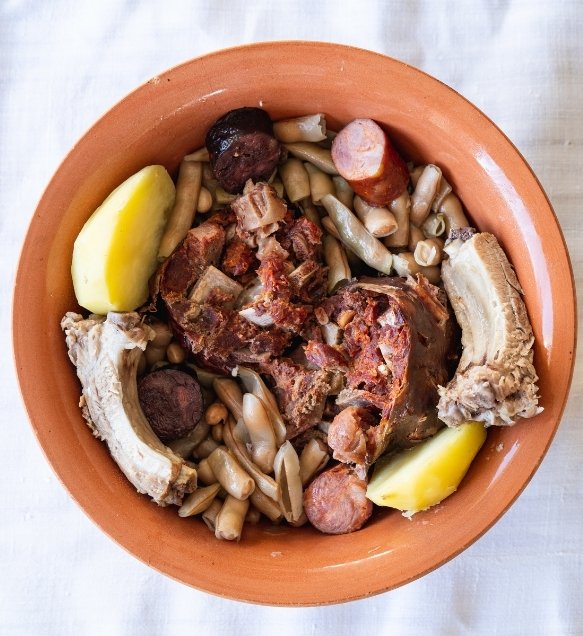
Butelo com cascas
On Carnival Day, especially in the cold regions of Trás-os-Montes, but also in many other areas where the tradition remains strong, this is the typical dish, also known as cozido mirandês.
The butelo is a smoked sausage made from pork ribs, suã (spinal meat), tails, and jowl, seasoned with salt, paprika, and garlic. It is cured and must be boiled before consumption. In this dish, butelo takes center stage, accompanied by cascas - also known as "vasas" or "casulas"—which are bean pods harvested when the beans are fully developed but not yet dry.
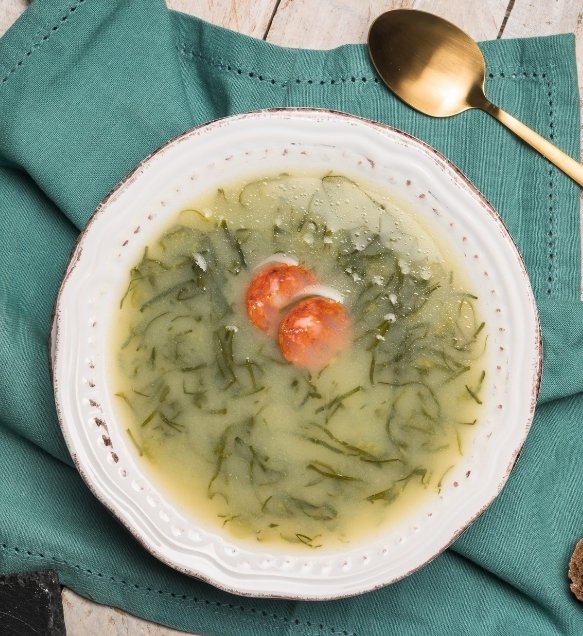
Caldo verde
A simple yet iconic soup, made with couve-galega (Portuguese kale), potatoes, and chouriço. It is traditionally served with broa, a rustic corn and rye bread.
This dish is considered one of the symbols of Portuguese cuisine, especially enjoyed during festivals and social gatherings. Its origins trace back to the rural areas of Minho, where it was valued for its simplicity and comforting flavor.
Folar de Chaves
A savory folar, filled with a rich combination of cured meats and pork, such as presunto, chouriço, salpicão and pork pieces. The dough is made with wheat flour, yeast, olive oil and pork lard, giving it a soft texture and a delicate flavor.
Did you know…? The tradition of Folar de Chaves is closely tied to Easter celebrations, when this stuffed bread was traditionally offered as a symbol of friendship and reconciliation.
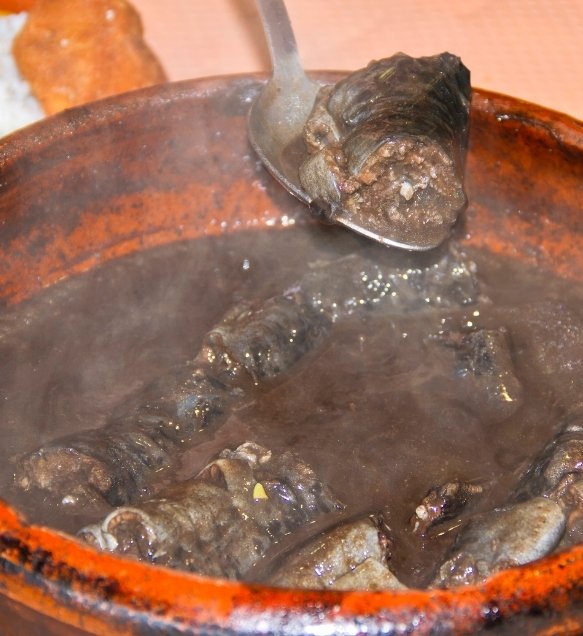
Lampreia à Bordalesa
A dish made with lamprey, a migratory fish, cooked in its own blood, along with red wine, onion, garlic, and a blend of spices.
Lamprey is artisanally fished in the Minho River and has a limited season, usually from January to April. Due to the difficulty of catching this fish, it is considered a luxury dish, highly prized in northern Portuguese cuisine.
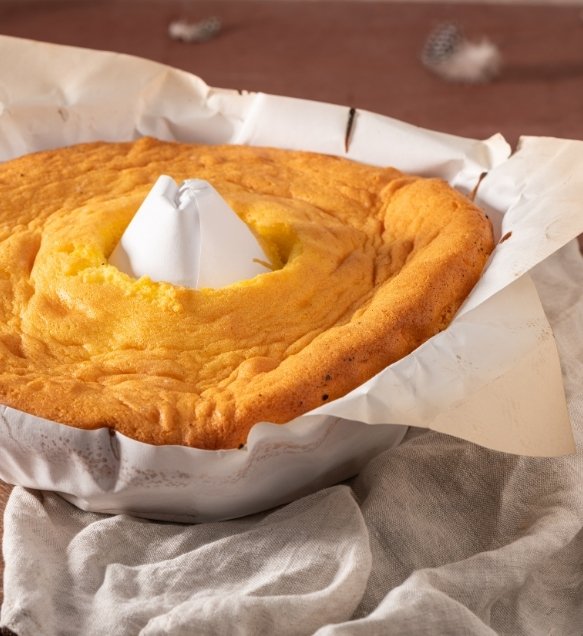
Pão-de-Ló de Margaride (Felgueiras)
A traditional sponge cake dating back to the 18th century, Pão-de-Ló de Margaride is known for its soft, slightly moist texture. It is often baked in clay molds, which give it a distinct flavor and unique presentation.
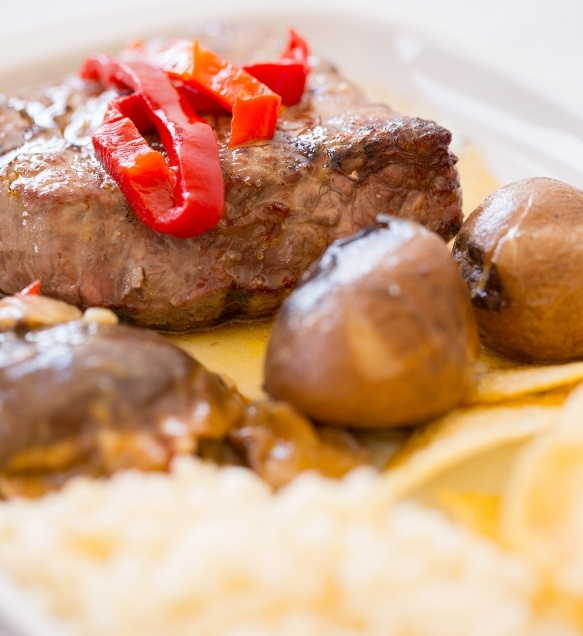
Posta Mirandesa (Miranda do Douro)
A grilled beef steak from the Mirandese breed, seasoned simply with coarse salt, often served with batatas a murro (smashed potatoes) and vegetables.
The Mirandese cattle breed, native to this region, is renowned for its high-quality meat, which holds the Protected Designation of Origin (DOP) certification.
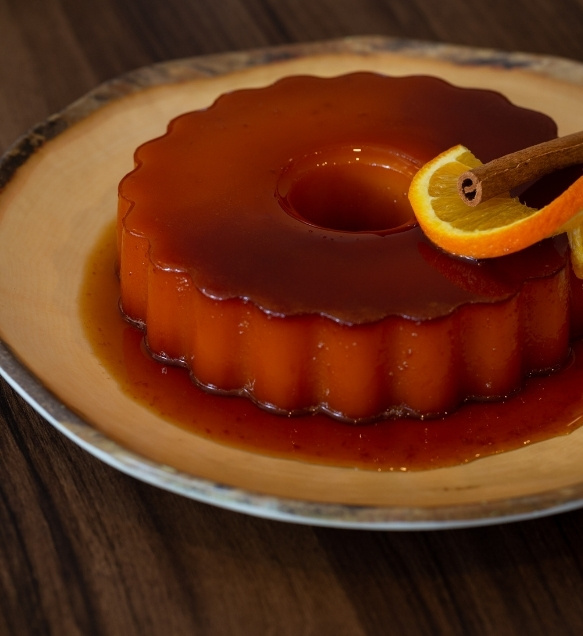
Pudim Abade de Priscos
This dessert dates back to the 19th century and was created by Abbot Manuel Joaquim Machado Rebelo, parish priest of Priscos, Braga. It is one of the most iconic desserts of Minho’s gastronomy.
What sets it apart is its rich flavor and silky texture, achieved through a unique combination of ingredients, including egg yolks, sugar, pork lard, and Port wine. The addition of pork lard gives this pudding its buttery consistency and a deep, distinctive flavor, making it unlike any other dessert.
Rojões
Although rojões can be found in various parts of Portugal, they are most traditional in Minho. This dish consists of boneless chunks of pork, served with blood sausages, flour-dusted tripe, and cooked pig’s blood, finely sliced.
It is typically accompanied by arroz de sarrabulho, plain white rice, or fried potatoes, making it a hearty and flavorful dish deeply rooted in Northern Portuguese cuisine.
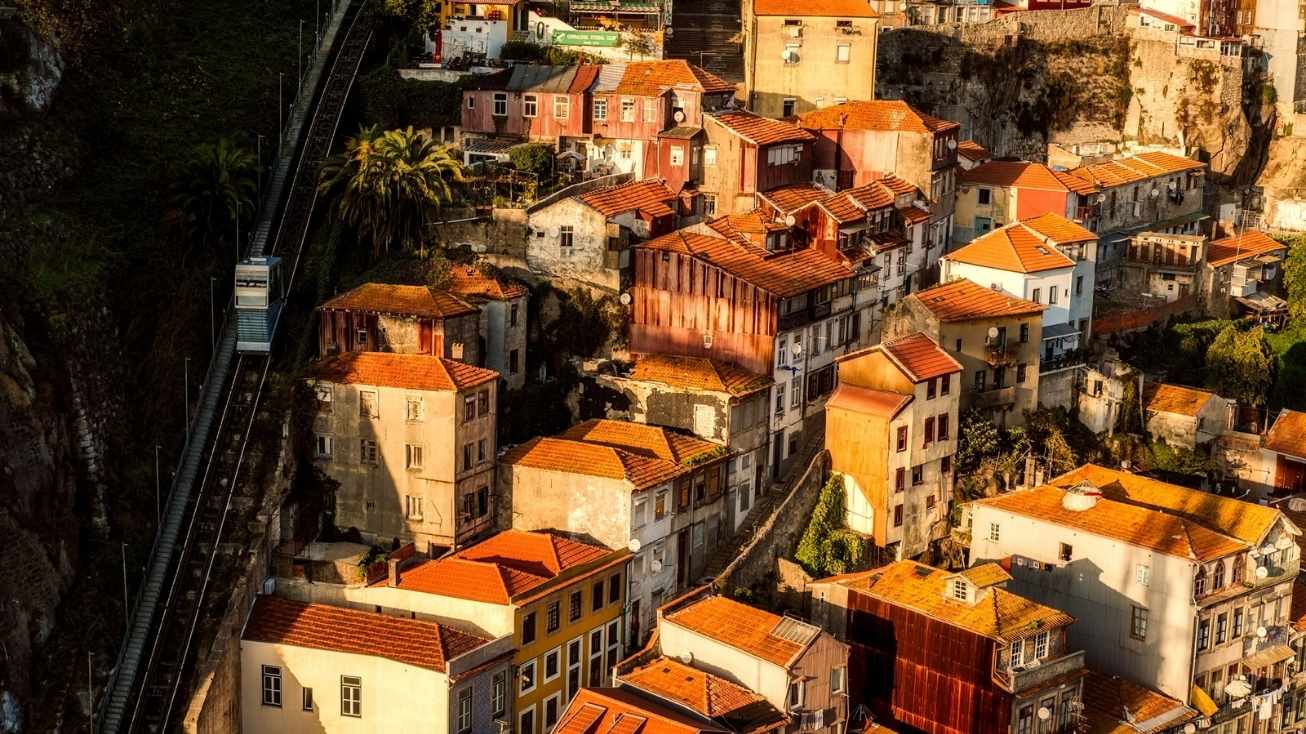
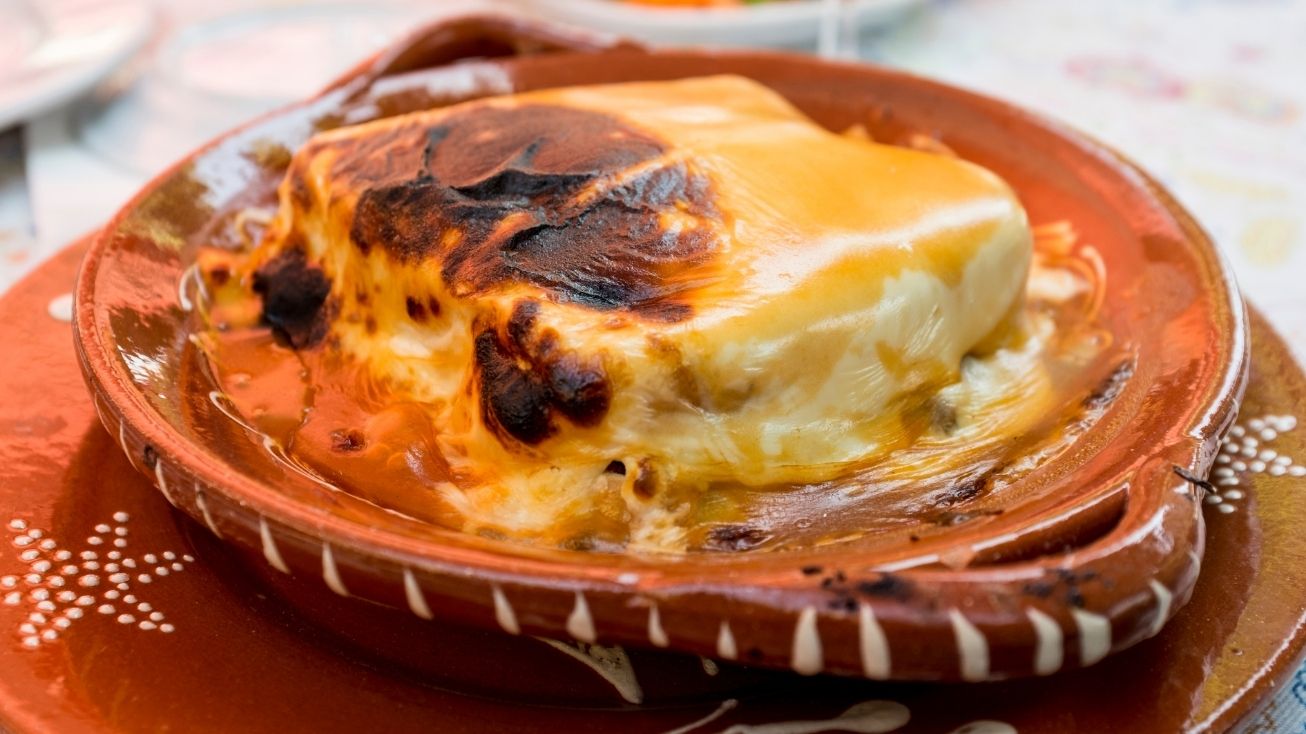
Porto: Europe’s Best Emerging Culinary Destination of 2024
In 2024, Porto was awarded the title of Best Emerging Culinary Destination in Europe by the World Culinary Awards, recognizing its growing and diverse gastronomic scene. This achievement highlights the city's prestige on the European stage, attracting an increasing number of visitors seeking unique culinary experiences.
This recognition reflects Porto’s vibrant food scene, where traditional cuisine meets innovation, thanks to talented chefs who reinterpret the region’s classic flavors. The award also underscores the significant role of Porto’s gastronomy in tourism and the local economy, reinforcing the city's status as a must-visit destination for food lovers.
Gastronomic Confraria: guardians of tradition
Gastronomic brotherhoods play a crucial role in preserving and promoting the culinary traditions of Northern Portugal. Composed of food enthusiasts and local producers, their mission is to honor and keep alive the distinct flavors and knowledge of the region’s cuisine. Here are some of the most prominent brotherhoods:
Confraria Gastronómica das Tripas à Moda do Porto
Dedicated to promoting the city’s emblematic dish, this brotherhood organizes events and competitions celebrating the heritage of Porto’s "Tripeiros".
Confraria do Vinho Verde
Based in Minho, this organization promotes and safeguards the quality and identity of Vinho Verde, one of the region’s most iconic and unique products.
Confraria Gastronómica do Sarrabulho à Moda (Ponte de Lima)
Committed to preserving this traditional Minho dish, the brotherhood plays a key role in events such as the Feiras Novas, where sarrabulho is an essential part of the festivities.
Confraria do Pão de Ló Tradicional
Focused on protecting centuries-old sponge cake recipes, such as Pão de Ló de Margaride, ensuring that traditional baking techniques are respected and passed down through generations.
These brotherhoods regularly organize gatherings, festivals, and public ceremonies, allowing them to share and celebrate the culinary wealth of Northern Portugal. Their efforts not only preserve traditions but also contribute to the region’s gastronomic tourism and cultural development.
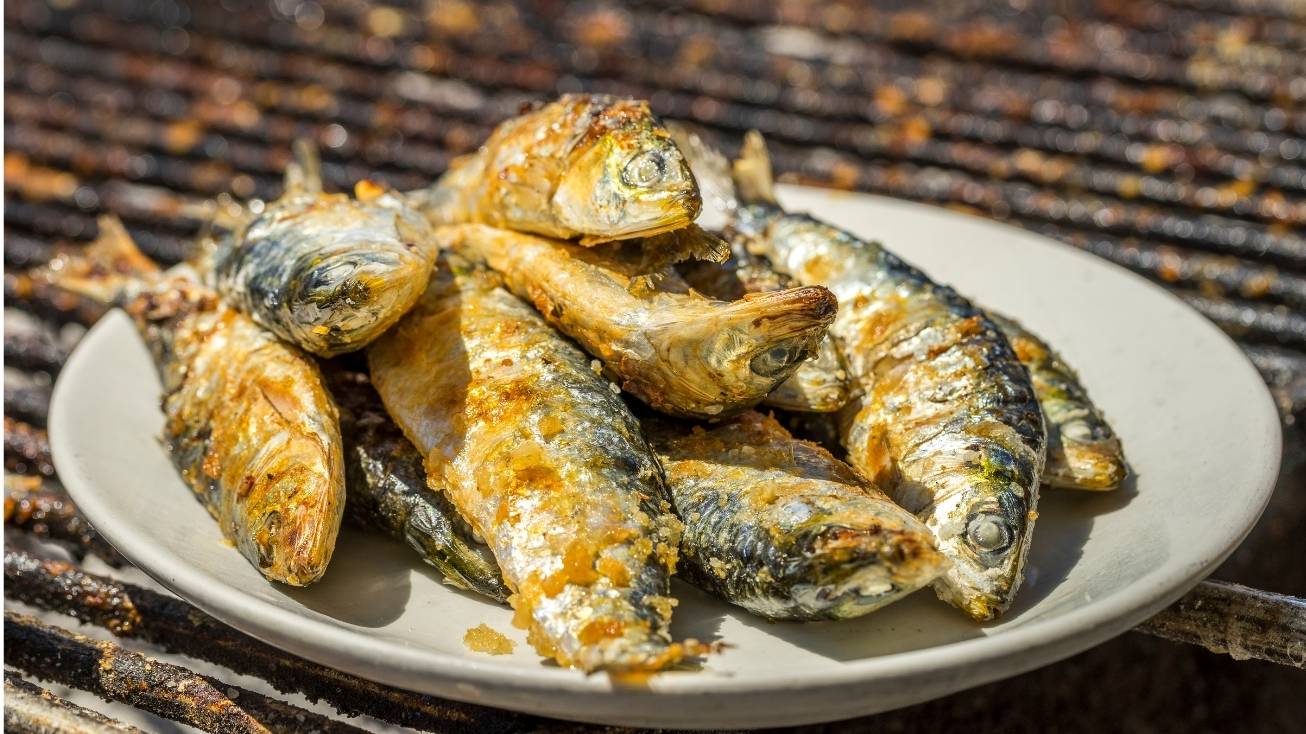

Celebrating gastronomy: 10 events showcasing the flavors of Northern Portugal
Festival do Bacalhau (Esposende)
Held annually, this festival celebrates codfish in its many forms, showcasing the versatility of Portugal’s most iconic fish. Local restaurants participate, offering special dishes and cooking workshops.
Feira do Fumeiro de Montalegre (Montalegre, Trás-os-Montes)
Taking place in January, this is one of the largest events dedicated to smoked meats and traditional Trás-os-Montes products. Visitors can enjoy artisan sausages like salpicão and butelo, while also experiencing cultural activities, concerts, and traditional dances.
Festa da Lampreia (Entre-os-Rios, Penafiel)
This annual event, usually held between February and April, celebrates lamprey, a river fish considered a delicacy. Visitors can taste lampreia à bordalesa at local restaurants and learn more about traditional fishing methods along the Douro River.
Festival Gastronómico Sabores de Anho (Marco de Canaveses)
Dedicated to roast lamb with baked rice, this festival takes place in the summer, bringing together local restaurants that prepare this dish in the traditional way. The event offers a festive atmosphere with live music and folk dances, making it a true celebration of rural cuisine.
Festival do Pão-de-Ló e Doces Tradicionais (Felgueiras)
Held in Margaride, this festival celebrates the famous Pão-de-Ló de Margaride, along with other traditional convent sweets. Visitors can discover local pastry traditions and sample renowned regional desserts, with participation from some of the most famous bakeries in Portugal.
Festival da Francesinha (Porto)
One of Porto’s most emblematic dishes, the francesinha is celebrated through this festival, where various restaurants compete to serve the best version of this iconic sandwich.
Feira dos Sabores de Ponte de Lima
Held in November, this fair gathers the best products from Minho, including arroz de sarrabulho, vinho verde, and cozido à portuguesa. The event blends gastronomy with music and folk dance performances, showcasing the region’s rich cultural heritage.
Festival de Peixe e Marisco de Matosinhos (Matosinhos)
Taking place in summer, this festival highlights fresh seafood, prepared by renowned chefs from local restaurants. Visitors can savor seabass, sardines, lobster, and other fresh fish, all sourced daily from Matosinhos’ fish market.
Feira do Vinho Verde e dos Produtos Regionais (Amarante)
Dedicated to the Vinho Verde of the region, this event also features local products such as cheeses and cured meats. Visitors can enjoy wine tastings, food pairings, workshops, and live entertainment.
Festa do Cozido à Portuguesa (Vieira do Minho)
In February, Vieira do Minho hosts a festival celebrating cozido à portuguesa, a traditional stew made with a variety of meats and vegetables. The event is a gathering of food lovers, offering a warm and festive environment that attracts visitors from across Portugal.
These gastronomic events offer the perfect opportunity to experience the flavors, traditions, and hospitality of Northern Portugal, making them must-visit experiences for food enthusiasts.